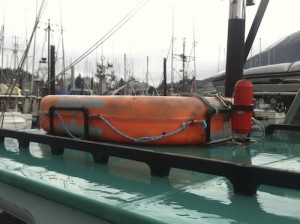New USCG Regulations for Commercial Fishing Vessels
Dockside Inspections
Some commercial fishing vessels will now have to undergo a mandatory Coast Guard dockside inspection, which was voluntary up until now. Commercial fishing vessels of any size – including catcher vessels, tenders and at-sea processors — that operate three nautical miles off the beach are required to have a dockside inspection prior to Oct. 15, 2015. Such inspections are also mandatory for those who participate in federal fisheries that carry onboard NOAA fisheries observers, mainly the black cod and halibut fisheries.
USCG Fishing Vessel Dockside Inspector Steve Ramp said vessel owners requiring a mandatory inspection – or those requesting a voluntary one – should contact him at 966-5620.
Ramp encouraged vessel owners to schedule a pre-exam meeting, noting they will save time overall if they do so.
“We will generate a customized checklist for their boat and where they operate. Then we go over it line by line so they can use it as a work list for getting ready for the exam,” Ramp said. “It drastically increases their chance of passing the exam on the first visit.”
The vessel requirements can be found online in section 46CFR, Part 28. They can also be found in a brochure that fills nearly 40 pages. Ramp said the pre-exam meeting can help vessel owners wade through the thickly worded regulations.
“We’ll whittle a 38-page brochure into a couple of pages of requirements for their specific boat,” Ramp said.
Ramp said the inspections are free and no fines are issued. Vessel owners who do not pass the inspection are given time to correct the problem. Vessels that pass are given a decal which is good for two years.
Vessel owners are also urged not to wait until the last minute to schedule their examinations, since there may be a backlog right before the deadline.
Survival Craft

A type of buoyant apparatus commonly found in Sitka. (Photo courtesy of Steve Ramp)
As of Feb. 15, 2016, the so-called “buoyant apparatus” will no longer meet the safety requirements for commercial fishing vessels operating more than three nautical miles offshore.
These devices are usually orange rectangles of buoyant foam, often 4 feet by 6 feet, and are meant for a number of people to cling to at once.
The new regulations call for survival craft that keep people out of the water, such as those that are self-inflating and mounted in a rigid canister. The regulations state the requirement is “a survival craft that ensures no part of an individual is immersed in water.”
Ramp said the buoyant apparatus was already unacceptable for vessels operating more than 12 nautical miles offshore, so that only those operating inside 12 miles are affected by the new rule.
